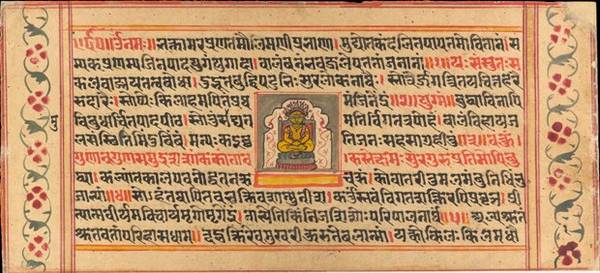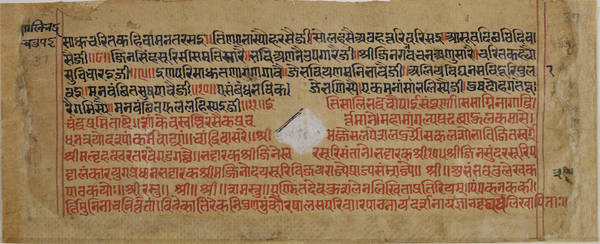How to read a Jain manuscript?

Typical manuscript page
Image by British Library © The British Library Board
Jain manuscripts have been created for hundreds of years. At an early date the teachings of the Jinas and their followers were transmitted orally. Later, around the 5th century CE, they were put into writing. But the manuscripts which have come down to us are no older than the 11th century.
A manuscript is defined by its material and format. It is a text written by hand by a scribe or copyist. There is a difference between the concept of:
- ‘text’, which relates to the contents
- ‘manuscript’ which relates to the object itself.
For example, a manuscript can be late in terms of the date it was written but contain a text composed much earlier.
Jain manuscripts can be surprising for readers who are unfamiliar with manuscripts, Indian languages and ancient traditions of decoration, numbering and layout. The structure of the writing and each page is often very different from the customs of the Western book. Finally, a manuscript is frequently a physical record of its creators, owners and readers.
Creation of manuscripts
The earliest Jain texts were written versions of the oral teachings of the Jinas and their chief disciples. The texts are in the Prakrit and Sanskrit languages. Prakrit is an almost dead language but Sanskrit is still used in Hindu rituals or by learned people like some Jain monks or pandits. A few thousand individuals speak Sanskrit in contemporary India.
Most surviving manuscripts are inked on to paper or palm leaf using inks from vegetable sources. The text is written in native Indian scripts. Those which are used in manuscripts of Jain texts are chiefly Devanāgarī, Tamil and Kannara. These are all read from left to right.
Devanāgarī is a script used to write several Indian languages, including Sanskrit and Prakrit but also Hindi, Gujarati, Rajasthani and Marāṭhī. In Devanāgarī each letter has a horizontal line above it. There are distinctive features in the manuscripts produced by Jains so the name ‘Jain Nāgarī‘ has been given to this style.
Numbering systems

Double folio numbering and marginalia
Image by British Library © The British Library Board
A traditional manuscript is made up of loose folios or sheets of paper or other material. A folio has two pages or sides. There is the recto side and the verso. These are often referred to as ‘r’ and ‘v’ or ‘A’ and ‘B’. First the reader looks at the recto and then turns the folio over to read the verso side.
When folios are numbered, the number is generally found on the verso side.
There are two principal systems of page numbering found in Jain manuscripts, which use, respectively:
- letters and syllables
- numerals.
Palm-leaf manuscripts characteristically use the first system, which is earlier. Some paper manuscripts also use this system, which is a sign of relative antiquity, dating production to the 1400s CE.
However, paper manuscripts usually use figures. In Jain Nāgarī some of these figures have a shape different from what is found in non-Jain nāgarī.
In manuscripts that use the numeral system, the page number is usually at the bottom of the right-hand margin while non-numeral page characters are written in the left margin.
Non-numeral page numbers
As a rule, in palm-leaf Jain manuscripts the numbering system uses letters and syllables as numbers. A few paper manuscripts also do this.
In the system of ‘letter-numerals’, each number or digit from 1 to 10 is represented by a different letter. The number 20 is represented by a particular letter, which is different from those used for 30, 40 and so on. The number 100 has its own letter, while 200 has another letter, 300 its particular letter and so on up to 400.
The highest letter-numeral in this system represents 400. This is probably because this numbering is found only in manuscripts and there is no example with pages numbered beyond 499.
Numbers with more than one digit, such as 34 or 258, are represented by two or three of these letters placed one above the other. There are variants in the forms of individual numbers used (Kapadia 1937; Appendix III and IV).
A few paper manuscripts on JAINpedia use this system of ‘letter-numerals’, such as:
- Or. 13455, held in the British Library
- the Kalpa-sutra in the collection of the Royal Asiatic Society.
The use of this system in a paper manuscript dates its period of production to the 15th century, making it a relatively old manuscript.
Page of a manuscript in Devanāgarī
Looking at an example page from a manuscript, the viewer can see that there are distinct parts of the layout. There are also standardised elements that can be used to explore each page more deeply.
Beginning of a manuscript
Auspicious phrase and picture
Image by British Library © The British Library Board
The beginning of a Jain manuscript is more or less standardised and consists of an:
- auspicious sign
- invocation phrase.
The auspicious sign is conventionally transcribed as Bhale. Although scholars have discussed the original sign, its meaning has not yet been explained satisfactorily.
The invocation phrase pays homage to a specific Jina or the Jinas.
The Hindu gods Gaṇeśa or Sarasvatī are often invoked too. Jains respect them as sources of inspiration and protection for creative and intellectual work.
The invocation is generally in Sanskrit, and follows the formula ‘Oṃ namo Vardhamānāya’ or ‘Oṃ namo Gaṇeśāya’. This means, ‘Om homage to Vardhamāna!’ or ‘Om homage to Gaṇeśa!’
Margins
Margins are interesting in Jain manuscripts. Far from being mere blank spaces around the text, they are often used to comment on it or as an area for decoration.
Margins are not compulsory so not all manuscripts have margins. Empty space is left above and below the text. On average there is about 5 centimetres of space.
If there are margins, they are often marked out by two double vertical lines on the left and right of the page.
Margins can be empty but they often contain numbers, decorations, picture captions or notes on the text.
Folio numbers can be shown in two ways:
- a verso side with the folio number at the bottom of the right-hand margin
- a recto can also have the folio number at the top of the left-hand margin, sometimes with an abridged form of the title of the work.
Decorations may be very elaborate, with flower motifs and patterns from nature. The most common ornamentation is a red or orange circle. Decorations can be either in the left or right margins.
Many illustrated manuscripts have the caption of the image in smaller script in the margin.
Notes in the margins of Jain manuscripts are very common.
Marginalia
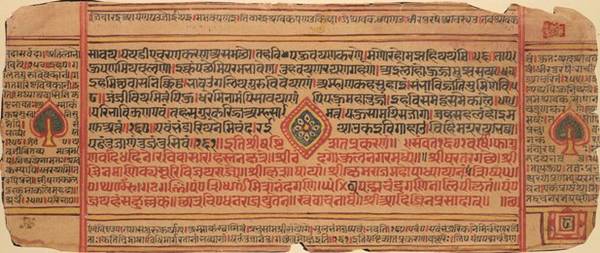
Pañca-pāṭha style of manuscript commentary
Image by British Library © The British Library Board
The free spaces of margins are very often where various readers of the manuscript have left some remarks. Mostly these are Gloss or explanations of difficult words or passages.
Commenting on the text was so normal that Jain manuscripts have developed two specific formats where the margins are extensively used for running commentaries. These are both written in small, even minute script.
In the form known as tri-pāṭha – ‘three readings’ – the top and bottom marginal spaces are large and are reserved for this purpose, with the main text in the centre.
In the form known as pañca-pāṭha – ‘five readings’ – the main text is again in the centre but all four margins are used for the commentary. Here, the reader goes in this order:
- top margin
- right margin
- left margin
- bottom margin.
This demonstrates how space is used efficiently, not wasting any paper.
Main part of the page
The paper is often ruled so that the text is mostly written straight and looks regular and even. But, of course, there are tidy and untidy manuscripts.
Words
The most striking feature for an outsider is that the text is written continuously, from left to right and top to bottom, without any break. The words are not divided.
Sometimes there is a small vertical stroke added above certain letters. These are word‑dividers added by later readers of the manuscript.
Punctuation

Writing, punctuation and verse numbers
Image by British Library © CC0 1.0 (Creative Commons Public Domain)
If a punctuation mark is used, it takes the form of one or two small vertical lines, which are known as daṇḍa – ‘stick’. A single line is used to indicate the end of a pāda – ‘part of a verse’ – while double lines mark out the end of the whole verse.
A daṇḍa can be in the normal black ink or in red.
Verses
When texts are in verse, stanza numbers can be marked. In Indian manuscripts the number is indicated at the end of the verse, not at the beginning.
This number can be in normal black ink or in red. It can stand alone or between two simple or double vertical lines. These daṇḍas – ‘sticks’ – are verse punctuation marks.
Where there are more than 100 verses, for instance 400, the usual system would be: 1, 2, 3… 99, 100, 1, 2, 3… 99, 200, 1, 2, 3… 99, 300, 1, 2, 3… 99, 400.
But there are also manuscripts where the numbers 201 and so on are fully given.
Sections or chapters
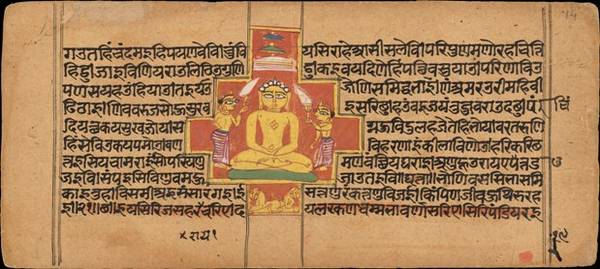
End of a chapter
Image by Wellcome Trust Library © Wellcome Library, London
In cases where a work is divided into several different sections, the section title and number may be given at the end of each one. It may be either in the normal black ink or in red or emphasised with red or orange powder.
Levels of text on a page
Many Jain texts are accompanied by an explanatory commentary in the same language as the main text or in a different one. There are a few ways of handling this visually on a page.
One method does not use a visual sign to distinguish the text from the commentary. They just follow each other without any special indication.
Another way shows just a few lines of large writing on the page. Each line is followed by blank spaces in which the commentary or glosses are found in smaller script. This layout is often used when the text is in Prakrit or Sanskrit and the commentary or glosses are in a vernacular language, such as Gujarati. Here, the commentary is more or less a word-for-word translation.
Finally, another technique has extensive commentary in the margins, as described above.
Central space
It is quite usual in Jain manuscripts to see a blank space in the centre of a page.
This blank space can be shaped like a square, rectangle or lozenge. It can be empty, filled with a red disc or a more ornate, colourful pattern, or filled with letters from the text itself, sometimes in an artistic way.
This space is a reminder of the hole found in earlier palm-leaf manuscripts. A cord was inserted through the hole and used to string together all the folios into one manuscript.
Manuscripts with paintings

Typical manuscript painting
Image by Victoria and Albert Museum © V&A Images/Victoria and Albert Museum, London
The standard place for a painting is on the right or on the left of the text. The standard size of a painting is 10 x 8 centimetres. The space is often marked out by lines forming a rectangle.
In some cases this space is empty, suggesting that the scribe perhaps reserved it for an illustration but that the painter did not fulfil his task.
But any other location is possible. There are many examples of small vignettes within the text, of full folios devoted to an illustration and of a large horizontal space for painting.
Not all pictures have captions. When found, they are generally in smaller script at the side of the painting. It is difficult to know who wrote them. It could be the scribe of the main text, who wrote it as an indication for the painter, or the painter himself.
Creators and readers of a manuscript
Each manuscript that has survived was produced by the activities of several people. How are these people involved and how are they identified in the text?
In Jain manuscripts they are often identified in a colophon. The colophon is found at the end, and is similar to the publication information at the beginning of modern books. It usually contains the title and sometimes details of the author, scribe and Sponsor. The colophons of Jain manuscripts may also include the names of owners, readers and libraries where they have been stored. They frequently have decorative elements.
Title
It is extremely rare to find the title given at the beginning of the manuscript. It is usually found at the end of the manuscript.
Many Jain manuscripts contain more than one work, however. In these cases the title of the work is given at the end of it, which is not at the end of the manuscript proper.
With works of several different sections, each section has its name at its end. The title of the full work is often also mentioned here.
The word iti usually goes before the title. It means ‘thus’. Therefore, for example iti Tattvārtha-sūtraṃ sampūrṇam can be translated as ‘thus is the Tattvārtha-sūtra finished’.
Author
Not all manuscripts or works have named authors. If there is an author, the name appears along with the title of text. This means that the author’s name is given at the end of the text. If it has several sections the author’s name is also stated at the end of each section.
There are sophisticated ways to mention the author’s name. For instance, if he is a monk, poetical formulas known as praśastis or ‘praise’ are used. They give his teachers’ names as well as his own.
Scribe
Not all scribes are named. If the scribe is identified, it is in the final part of the manuscript, usually in the formula ‘copied likhitam by X’.
The scribes are either professionals or Jain monks. If they are monks, details of their spiritual affiliation are often given.
Sponsors
If any people sponsored or commissioned the manuscript to be copied, their names and social status may appear at the end of the document.
In this part several abbreviations for social standing may be used.
Owners and readers
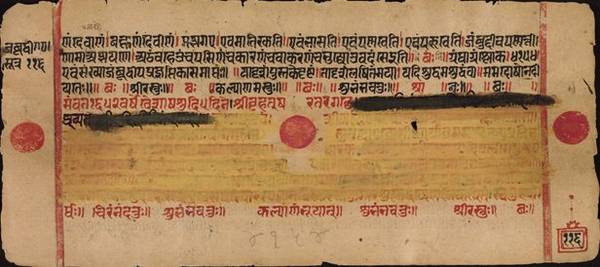
Partly erased colophon
Image by Bodleian Libraries, University of Oxford © Bodleian Libraries, University of Oxford
It often happens that basic information, such as the title and author, is followed by records of the owner or reader.
The various names are frequently written in different hands, demonstrating how ownership changes.
Sometimes it is clear that an owner or reader has replaced an earlier name with his own, using yellow or white pigment as erasers.
Library references
Any library references are found at the end of a manuscript, either after the text or on the reverse of the folio. They are added after the creation and delivery of the manuscript.
Library marks are generally in the form: ‘manuscript number X, box number X’. These refer to the traditional way of keeping manuscripts in Jain temple libraries, where several manuscripts are put in large wooden boxes until they are full. These may then be put in cupboards. Hence the reference system is meaningful only at a local level.
When the manuscript is out of context, the meaning of these numbers disappears. For modern readers, these library marks have lost their significance.


